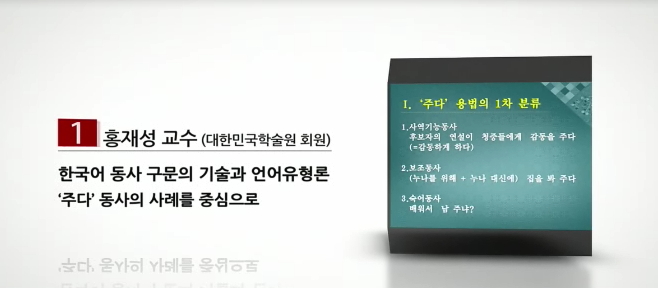This study aims to clarify the adnominal possessive construction in Korean and Japanese from the viewpoint of linguistic typology. Both languages belong to the dependent-marked language type according to linguistic typology. In terms of synchrony, a m...
http://chineseinput.net/에서 pinyin(병음)방식으로 중국어를 변환할 수 있습니다.
변환된 중국어를 복사하여 사용하시면 됩니다.
- 中文 을 입력하시려면 zhongwen을 입력하시고 space를누르시면됩니다.
- 北京 을 입력하시려면 beijing을 입력하시고 space를 누르시면 됩니다.

言語類型論의 관점에서 본 韓·日 修飾的 所有構文에 대한 대조 연구 = Adnominal possessive construction in Korean and Japanese from a linguistic typology viewpoint
한글로보기https://www.riss.kr/link?id=A108280921
-
저자
김희성 (경희대학교)
- 발행기관
- 학술지명
- 권호사항
-
발행연도
2022
-
작성언어
Korean
-
주제어
소유 ; 수식적 소유구문 ; 언어유형론 ; 한일대조 ; 도상성 ; 소유 유형 ; 소유표지 ; This study aims to clarify the adnominal possessive construction in Korean and Japanese from the viewpoint of linguistic typology. Both languages belong to the dependent-marked language type according to linguistic typology. In terms of synchrony ; a morphosyntactic difference due to the separability of Pr-Pe’s relations is not observed in Korean. In Japanese ; however ; ‘ga’ appears only in inalienable possessive expression ; compared to the unmarked marker ; ‘no.’ As such ; a morphosyntactic difference exists. In addition ; ‘Pr∅Pe’ in Korean and ‘∅Pe’ in Japanese can be understood as ‘structural tightness.’ This is one of the linguistic typological features of adnominal possessive construction ; which can be explained using the principle of grammatical iconicity. With adnominal possessive construction in the ‘Pe-Pr’ order ; both Korean and Japanese have the form ‘modifier + Pe + possessive marker + Pr’ when referring to the possession of a body part ; abstract possession of animate Pr ; inalienable possession of an inanimate Pr ; as well as abstract possession of an abstract Pr. However ; in Japanese ; such combination can also be used when expressing the possession of the clothes Pr is wearing. It is presumed Japanese shows a more productive pattern in the inverse adnominal possessive construction ; Japanese has a nominal-oriented structure ; while Korean has a verbal-oriented structure.
-
등재정보
KCI등재
-
자료형태
학술저널
-
수록면
35-75(41쪽)
- DOI식별코드
- 제공처
- 소장기관
-
0
상세조회 -
0
다운로드
부가정보
다국어 초록 (Multilingual Abstract)
This study aims to clarify the adnominal possessive construction in Korean and Japanese from the viewpoint of linguistic typology. Both languages belong to the dependent-marked language type according to linguistic typology. In terms of synchrony, a morphosyntactic difference due to the separability of Pr-Pe’s relations is not observed in Korean. In Japanese, however, ‘ga’ appears only in inalienable possessive expression, compared to the unmarked marker, ‘no.’ As such, a morphosyntactic difference exists. In addition, ‘Pr∅Pe’ in Korean and ‘∅Pe’ in Japanese can be understood as ‘structural tightness.’ This is one of the linguistic typological features of adnominal possessive construction, which can be explained using the principle of grammatical iconicity. With adnominal possessive construction in the ‘Pe-Pr’ order, both Korean and Japanese have the form ‘modifier + Pe + possessive marker + Pr’ when referring to the possession of a body part, abstract possession of animate Pr, inalienable possession of an inanimate Pr, as well as abstract possession of an abstract Pr. However, in Japanese, such combination can also be used when expressing the possession of the clothes Pr is wearing. It is presumed Japanese shows a more productive pattern in the inverse adnominal possessive construction; Japanese has a nominal-oriented structure, while Korean has a verbal-oriented structure.
국문 초록 (Abstract)
김희성, 2022, 언어유형론의 관점에서 본 한·일 수식적 소유구문에 대한 대조 연구, 어문연구, 195 : 35~75 본 연구에서는 언어유형론적으로 종속부 표시형 언어에 속하는 한국어와 일본어의 수...
김희성, 2022, 언어유형론의 관점에서 본 한·일 수식적 소유구문에 대한 대조 연구, 어문연구, 195 : 35~75 본 연구에서는 언어유형론적으로 종속부 표시형 언어에 속하는 한국어와 일본어의 수식적 소유구문을 대조, 분석해 보았다. 공시적으로 보았을 때 한국어는 소유관계의 분리가능성에 의한 형태·통사상의 차이가 나타나지 않으나 일본어는 ‘が(ga)’가 분리불가능한 소유에서만 나타나기 때문에 무표적인 ‘の(no)’와 비교하여 형태·통사상의 차이가 있다. 또한 한국어의 ‘Pr ∅ Pe’와 일본어의 ‘∅Pe’를 수식적 소유구문의 언어유형론적 특징 가운데 하나인 ‘구조적 긴밀성’으로 이해할 수 있는데 이는 문법 도상성의 관점에서 설명 가능하다. 한편 소유물-소유주 어순의 수식적 소유구문의 경우 한국어와 일본어 모두 신체 부분 소유, 유정물 소유주의 추상물 소유, 무정물 소유주의 분리불가능한 소유, 추상적 소유주의 추상물 소유에서 ‘수식요소+Pe+소유표지+Pr’의 형태로 나타나는데, 일본어에서는 착용 중인 의류의 소유에서도 사용 가능하다. 역순의 수식적 소유구문에서 일본어가 보다 생산적인 양상을 보이는 것은 한국어가 동사지향의 표현구조의 언어임에 비해 일본어는 명사지향 표현구조의 언어이기 때문으로 추측된다.
참고문헌 (Reference)
1 김희성, "한국어와일본어술어적 소유구문의 대조연구" 경희대학교 2022
2 목정수, "한국어 조사 {의}의 문법적 지위와 의미 기능에 대하여" 한국어교육학회 (123) : 437-470, 2007
3 이종근, "한국어 속격 표지 ‘의’의 분포와 속격의 본질" 한국생성문법학회 25 (25): 277-306, 2015
4 박소영, "한국어 속격 ‘의’의 실현과 DP 가설" 한국생성문법학회 24 (24): 613-629, 2014
5 이선웅, "한국어 문법론의 개념어 연구" 도서출판 월인 346-, 2012
6 구본관, "한국어 문법 총론 I" 집문당 34-, 2018
7 안덕호, "최소주의적 관점에서의 소유격: 한국어를 중심으로" 한국언어학회 37 (37): 607-621, 2012
8 임홍빈, "존재 전제와 속격 표지 {의}" 한국외국어대학교 언어연구소 7 : 61-78, 1981
9 미야지마 토모미, "일본인 중급 학습자를 위한 한국어 동사적 표현구조 교육 연구" 서울대학교 2019
10 김희성 ; 이선웅, "언어유형론적 관점에서 본 한국어와 일본어의 술어적 소유구문" 우리말글학회 91 : 1-33, 2021
1 김희성, "한국어와일본어술어적 소유구문의 대조연구" 경희대학교 2022
2 목정수, "한국어 조사 {의}의 문법적 지위와 의미 기능에 대하여" 한국어교육학회 (123) : 437-470, 2007
3 이종근, "한국어 속격 표지 ‘의’의 분포와 속격의 본질" 한국생성문법학회 25 (25): 277-306, 2015
4 박소영, "한국어 속격 ‘의’의 실현과 DP 가설" 한국생성문법학회 24 (24): 613-629, 2014
5 이선웅, "한국어 문법론의 개념어 연구" 도서출판 월인 346-, 2012
6 구본관, "한국어 문법 총론 I" 집문당 34-, 2018
7 안덕호, "최소주의적 관점에서의 소유격: 한국어를 중심으로" 한국언어학회 37 (37): 607-621, 2012
8 임홍빈, "존재 전제와 속격 표지 {의}" 한국외국어대학교 언어연구소 7 : 61-78, 1981
9 미야지마 토모미, "일본인 중급 학습자를 위한 한국어 동사적 표현구조 교육 연구" 서울대학교 2019
10 김희성 ; 이선웅, "언어유형론적 관점에서 본 한국어와 일본어의 술어적 소유구문" 우리말글학회 91 : 1-33, 2021
11 Whaley, L. J, "언어 유형론: 언어의 통일성과 다양성" 소통 189-190, 2010
12 홍용철, "소유격 표지 “의”의 분포와 본질" 한국생성문법학회 23 (23): 321-345, 2013
13 김천학, "소유 관계와 소유 구성" 한국어의미학회 39 : 125-148, 2012
14 김창섭, "문어와 구어에서의 조사 ‘의’의 문법" 진단학회 (106) : 79-115, 2008
15 박정섭, "명사구에서의 논항 실현에 관한 고찰 - 불어와 한국어를 중심으로 -" 한국프랑스어문교육학회 16 : 223-248, 2003
16 이선웅, "국어 명사의 논항구조 연구" 도서출판 월인 2005
17 최경봉, "국어 명사 관형구성의 의미결합 관계에 대한 고찰" 국어학회 26 : 3-58, 1995
18 김인균, "관형 명사구의 구조와 의미 관계" 국어학회 41 : 197-223, 2003
19 김기혁, "관형 구성의 통어 현상과 의미 관계" 한글학회회 209 : 59-97, 1990
20 홍용철, "고유 명사와 “의”의 의무적 출현: “의”가 수식어 표지라는 한 증거" 한국언어학회 41 (41): 761-779, 2016
21 이남순, "격표지의 비실현과 생략" 국어학회 31 : 339-360, 1998
22 桃内佳雄, "譲渡不可能な所有対象の表現について" 北海学園大学工学部 77-84, 2002
23 影山太郎, "語彙意味論の問題" 大阪大学言語文化部 6 : 1-20, 1980
24 国広鉄弥, "構造的意味論ー日英両語対照研究ー" 三省堂 1967
25 金恩愛, "日本語の名詞志向構造と韓国語の動詞志向構造" 朝鮮学会 188 : 1-83, 2003
26 津田早苗, "日·英語談話スタイルの対照研究" ひつじ書房 1-14, 2015
27 林八龍, "日 韓両語の表現構造の対照研究ー日本語の名詞的表現に対する韓国語の動詞的表現を中心にー" 韓国日語日文学会 50 : 429-456, 2004
28 久野すすむ, "新日本文法研究" 大修館書店 1983
29 高橋太郎, "文中におらわれる所属関係の種々相" 103 : 1-17, 1975
30 寺村秀夫, "国語シリーズ別冊 -日本語と日本語教育" 文化庁 1975
31 鈴木康之, "名詞と名詞とのくみあわせ" 25-40, 1968
32 ベルント·ハイネ, "ことばはなぜ今のような姿をしているのかー文法の認知的基盤" 関西学院大学出版会 115-252, 2017
33 角田太作, "『世界の言語と日本語』第 刷" くろしお出版 125-176, 2017
34 Hall, E. T., "The dance of life: The other dimension of time" Anchor Books 1983
35 Haiman, J., "The Iconicity of Grammar: Isomorphism and Motivation" 56 (56): 515-540, 1980
36 Nichols, J., "Shipley, In honor of Mary Hass" 557-609, 1988
37 Stassen, L, "Predicative Possession" Oxford Unversity Press 2009
38 Taylor, J. R., "Possessives in English" Oxford University Press 340-, 1996
39 Nishiguchi, S., "Possessive Disambiguation" Osaka University 2009
40 Seiler, H, "Possession: Variation and Invariance, Universality in language beyond grammar" Universitätsverlag Brockmeyer 8-, 2008
41 Heine, B, "Possession: Cognitive sources, forces, and grammaticalizaton" Cambridge University Press 2006
42 Seiler, H, "Possession: As an operational dimension of language" Gunter Narr 4-7, 1983
43 Alexandra Y. Aikhenvald, "Possesseion and Ownership: A Cross Linguistic Typology" Oxford Unversity Press 6-8, 2013
44 Nichols, J., "Linguistic diversity in space and time" University of Chicago Press 116-123, 1992
45 Taylor, J. R., "Linguistic categorization: Prototypes in linguistic theory" Clarendon Press 1989
46 Haiman, J., "Iconic and Economic Motivation" 59 (59): 793-795, 1983
47 Nichols, J., "Head-Marking and Dependent-Marking Grammar" 62 : 56-119, 1986
48 Hirtle, W. H., "Ed adjectives like ‘verandahed’ and ‘blue-eyed’" 6 : 19-36, 1970
49 Heine, B, "Cognitive Foundations of Grammar" Oxford University press 104-, 1997
50 Hall, E. T., "Beyond culture" Anchor Books 1976
51 Dixon, R. M. W, "Basic linguistic theory, Vol.2" Oxford Unversity Press 301-, 2010
동일학술지(권/호) 다른 논문
-
- 한국어문교육연구회
- 정우헌
- 2022
- KCI등재
-
- 한국어문교육연구회
- 김진우
- 2022
- KCI등재
-
딥러닝 基盤의 諺簡 資料 文字 判讀機 具現에 對한 硏究 –<秋史 諺簡>을 對象으로–
- 한국어문교육연구회
- 이홍구
- 2022
- KCI등재
-
- 한국어문교육연구회
- 박윤자
- 2022
- KCI등재




 KCI
KCI KISS
KISS







